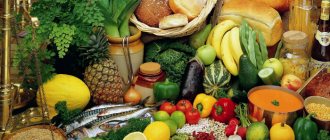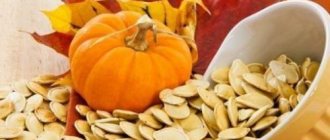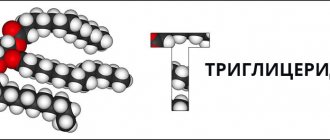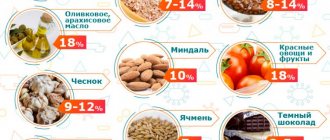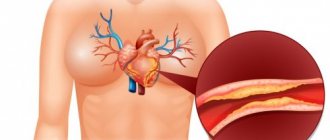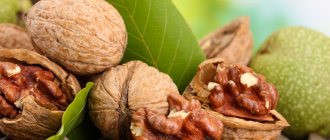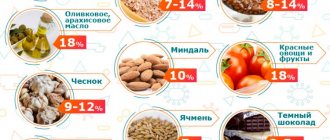We all regularly hear from doctors that blood cholesterol levels should be maintained at a constant and fairly low level. As a result, this substance seems to many people far from medicine to be almost a source of evil, the presence of which in the body is associated exclusively with negative consequences. In fact, this is not true at all.
First of all, let us recall that cholesterol is an organic compound that not only enters the human body with food, but is also synthesized by our liver. It is necessary to prevent premature aging, and also helps the body absorb fats and fat-soluble vitamins. According to doctors, normal blood cholesterol levels range from 3.6 to 5.2 mmol/l. Moreover, the upper limit may vary depending on the gender of the person and the age category to which he belongs.
One of the natural properties of cholesterol is the following: during blood circulation, it “sticks together”, as a result of which its accumulations, the so-called atherosclerotic plaques, appear on the walls of blood vessels. They interfere with normal blood circulation, resulting in oxygen starvation of the tissues of the brain, heart and other organs. Also, blocking of blood vessels with atherosclerotic plaques is fraught with strokes and heart attacks. Therefore, doctors insist that blood cholesterol levels should be regularly monitored.
What to do if the study shows an increase in cholesterol levels? In addition to medications, proper nutrition will help normalize the indicator. Nutritionists are well aware that a number of foods have “anticholesterol” properties—in other words, they help break down excess cholesterol.
Nuts
All types of nuts are an excellent source of healthy saturated fats. Essential fatty acids omega-3 and omega-6 prevent the occurrence of atherosclerotic changes in blood vessels. Almonds and cashews contain magnesium, which increases the elasticity of blood vessels and helps dissolve plaques. In addition, most nuts contain flavonoid pigments - special plant compounds that help strengthen arterial walls. Peanuts, tree nuts and almonds help avoid fatty liver disease, as a result of which its function is normalized.
Please note that if cholesterol increases, nuts should be eaten unprocessed, since high temperatures destroy the beneficial substances in them.
Prevention of excess cholesterol
For modern people, it is important to know that there is no specific prevention for reducing this substance. Therefore it is necessary:
- change your lifestyle;
- give up bad habits (smoking, reducing alcohol consumption);
- eat rationally. Among the diets that doctors prescribe, the Mediterranean diet should be noted. It includes eating plenty of greens, vegetables, fruits, legumes, lean turkey and chicken, and eating lean fish;
- engage in physical exercise. Nordic walking, swimming or walking for more than 2 hours a day helps improve your health.
Exercise helps in lowering cholesterol.
This is what has a positive effect on health and reduces the risk of atherosclerosis, and as a result, such severe socially significant diseases as myocardial infarction, acute cerebrovascular accident and other vascular accidents.
It is not for nothing that it is said that doctors treat diseases, but you need to achieve health yourself.
Flax seed
Flax seeds and oil from them have long been used to improve the health of the body. First of all, flax seeds contain fiber, which helps retain fat and cholesterol in the digestive system, as a result of which the content of the latter in the blood is significantly reduced. In addition, vitamins B3 have a positive effect on fat metabolism, thereby reducing the content of low-density lipoproteins in the blood, which, when oxidized, can form atherosclerotic plaques. Finally, the selenium found in flax seeds helps increase good cholesterol and reduce bad cholesterol. You can use flax seed as an ingredient in salads, in the preparation of porridges and breadings.
What is cholesterol for?
It is important to note that it is vital for a living organism. This substance is included as a material for building the cell wall. The higher its content, the denser the wall and the more capable of survival, which generally has a beneficial effect on the human body. It also protects against cell destruction by free oxygen radicals. Contained in the skin, and under the influence of solar ultraviolet rays it is converted into vitamin D, which, in turn, is necessary for calcium metabolism.
In the liver, bile acids are formed from cholesterol, which are used for the absorption and breakdown of fats in the small intestine. More than 80% of this substance is formed daily in the body, the remaining percentage comes with food.
With a decrease in dietary intake, men experience a decrease in sexual activity, and women experience amenorrhea (absence of menstruation). In addition, with a strict hypocholesterol diet in women of reproductive age, the likelihood of pregnancy is reduced.
Cholesterol is an essential component for myelinated fibers in the brain and is also required for serotonin receptors. Serotonin is responsible for a good mood and ensuring favorable conditions for the functioning of the brain.
Cholesterol is necessary for favorable conditions for brain function.
Is it possible to drink alcohol?
This question worries many patients with high blood cholesterol, because they often receive offers to go on a visit, celebrate a significant event, etc. Is it possible to skip a glass of alcohol or should you refrain from even the minimum dose of strong drinks?
It all depends on two factors: what dose of the drink will be taken, and also what type of alcohol it is. Strong drinks have different effects on the body, including the harmful cholesterol present in the blood vessels:
- vodka - doctors do not note any beneficial effects for this drink; on the contrary, they consider it dangerous. Many manufacturers add to their products, instead of the required ethyl alcohol, a cheap substitute - methyl alcohol. As a result, even 30 gr. the poison consumed will be enough not only to not lower cholesterol, but also to lose life;
- Whiskey is a natural drink made from malt, rich in ellagic acid. It has a pronounced effect on bad cholesterol, being a good antioxidant. Fights harmful substances, removes toxins, but only with regular small amounts of whiskey consumed;
- cognac – approximately 30–50 grams of cognac per week will help lower cholesterol levels and improve vascular tone. Consumption of large doses reduces the effect and leads to the development of alcoholism;
- dry wine – reduces the level of harmful substances in the blood, gives tone to blood vessels, neutralizes the effect of free radicals.
When taking statins and other groups of drugs that a doctor may prescribe, drinking alcohol is contraindicated due to severe side effects on the liver. Therefore, before drinking even a glass of “healthy” dry wine, you need to make sure there are no contraindications.
Why is an elevated level dangerous?
With high “bad” cholesterol (LDL and VLDL), due to a long-term defect in fat metabolism, serious cardiovascular complications may develop:
- Cardiac ischemia. It is caused by damage to the coronary arteries by atherosclerotic plaques, which gradually reduce the flow of blood and nutrients to the heart muscle. When the blockage of the vessel is significant, angina pectoris is formed - chest pain with any physical activity. When the artery is completely blocked, myocardial infarction develops - necrosis of the heart muscle and disruption of systemic hemodynamics.
- Stroke. It can be ischemic (obstruction of the lumen of a cerebral artery by a migrating thrombus, followed by necrosis of the brain substance) or hemorrhagic (the main cause is atherosclerotic damage to the vessels of the central parts of the nervous system with increased permeability and fragility, when any stress factor (hypertensive crisis, blood clot) can lead to rupture and melting of brain matter).
- Chronic cerebral ischemia. It is a narrowing of the extracranial arteries with decreased oxygenation of the brain. The severity of cognitive functions (memory, attention, thinking) gradually decreases, and atrophic and dystrophic changes form.
- Atherosclerosis of the vessels of the lower extremities. They lead to various gait disturbances (“intermittent claudication”) and necrosis of the distal parts of the legs (fingers, feet).
Against the background of atherosclerosis, blood viscosity increases significantly, which aggravates the course of other somatic pathologies, and the activity of other components of the metabolic syndrome (arterial hypertension, obesity, type II diabetes mellitus, gout) sharply increases.
Expert commentary
Kardash Anton Borisovich
Therapist, cardiologist. Doctor of the highest category.
Treatment of atherosclerosis must be comprehensive. For prevention or in the initial stages, the use of folk remedies in combination with normalization of diet and lifestyle changes is allowed. In severe cases, medication support is required.
General principles of dietary nutrition
Each person can create an approximate menu for himself from products allowed for consumption (this is described below). But an important point of the diet is the daily consumption of complex carbohydrates (their volume should be 50–60% of the total food eaten per day).
Complex carbohydrates that take a long time to digest and provide a feeling of fullness include pasta, cereals, whole grain bread, as well as fruits and vegetables. Fruit salads and vegetable dishes cleanse blood vessels of cholesterol deposits, give them tone, and make capillaries elastic and less brittle. A third of all vegetables eaten per day should be consumed raw.
Proteins are fish, lean meats and cottage cheese. Preference is given to poultry meat with the skin removed, and it is better to stew or boil it rather than fry it. For a side dish, it is better to choose stewed vegetables or complement the meat dish with fresh vegetable salad. This way the meat is digested more efficiently.
Egg whites are cholesterol-free, so you can eat them without restricting yourself. But the yolk contains substances that help increase the levels of the substance in the blood, which is why you are allowed to eat no more than three yolks per week. Dairy products should be chosen low-fat.
Small meals are another important point in the fight against bad cholesterol. It is better to eat food more often (up to 5–6 times a day), but in small portions, than to eat 1–2 times, but in large quantities. This facilitates the work of the gastrointestinal tract, creating a feeling of constant satiety. If you feel like you have an “empty stomach,” you can drink a glass of natural yogurt or low-fat kefir.
No ads 2
Fully or partially limited products
Excluded: pork, cooking fats, refined vegetable oil, margarine, butter, duck and goose meat, offal (kidneys, brains, liver), sausages and smoked meats. Fatty fish, fish roe (contains a large amount of cholesterol), crayfish, shrimp, crabs and any canned fish, including cod liver, are prohibited.
You should not consume puff pastry and pastry products, highly extractive meat, fish, or mushroom broths. Cream, fatty cottage cheese and sour cream are not allowed in the diet. Prohibition of consumption of chocolate, full-fat ice cream, products with cream and products with palm and coconut oil. Mayonnaise and ketchup should not be used as sauces.
Limit:
- beef (1-2 times a week);
- red fish;
- egg yolks;
- potato;
- fatty cheeses;
- nuts;
- buckwheat;
- honey.
Table of prohibited products
| Proteins, g | Fats, g | Carbohydrates, g | Calories, kcal | |
Fruits | ||||
| bananas | 1,5 | 0,2 | 21,8 | 95 |
Nuts and dried fruits | ||||
| raisin | 2,9 | 0,6 | 66,0 | 264 |
Cereals and porridges | ||||
| semolina | 10,3 | 1,0 | 73,3 | 328 |
| white rice | 6,7 | 0,7 | 78,9 | 344 |
Flour and pasta | ||||
| pasta | 10,4 | 1,1 | 69,7 | 337 |
Bakery products | ||||
| bagels | 16,0 | 1,0 | 70,0 | 336 |
| bagels | 16,0 | 1,0 | 70,0 | 336 |
| crackers | 11,2 | 1,4 | 72,2 | 331 |
Confectionery | ||||
| jam | 0,3 | 0,2 | 63,0 | 263 |
| jam | 0,3 | 0,1 | 56,0 | 238 |
| candies | 4,3 | 19,8 | 67,5 | 453 |
| pastry cream | 0,2 | 26,0 | 16,5 | 300 |
Ice cream | ||||
| ice cream | 3,7 | 6,9 | 22,1 | 189 |
Cakes | ||||
| cake | 4,4 | 23,4 | 45,2 | 407 |
Chocolate | ||||
| chocolate | 5,4 | 35,3 | 56,5 | 544 |
Raw materials and seasonings | ||||
| ketchup | 1,8 | 1,0 | 22,2 | 93 |
| mayonnaise | 2,4 | 67,0 | 3,9 | 627 |
Dairy | ||||
| cream | 2,8 | 20,0 | 3,7 | 205 |
| sour cream 30% | 2,4 | 30,0 | 3,1 | 294 |
| sour cream 40% (fat) | 2,4 | 40,0 | 2,6 | 381 |
Cheeses and cottage cheese | ||||
| cheese | 24,1 | 29,5 | 0,3 | 363 |
| cottage cheese 18% (fat) | 14,0 | 18,0 | 2,8 | 232 |
Meat products | ||||
| pork | 16,0 | 21,6 | 0,0 | 259 |
| pork liver | 18,8 | 3,6 | 0,0 | 108 |
| pork kidneys | 13,0 | 3,1 | 0,0 | 80 |
| pork fat | 1,4 | 92,8 | 0,0 | 841 |
| salo | 2,4 | 89,0 | 0,0 | 797 |
| beef liver | 17,4 | 3,1 | 0,0 | 98 |
| beef kidneys | 12,5 | 1,8 | 0,0 | 66 |
| beef brains | 9,5 | 9,5 | 0,0 | 124 |
| mutton | 15,6 | 16,3 | 0,0 | 209 |
Sausages | ||||
| smoked sausage | 16,2 | 44,6 | 0,0 | 466 |
| smoked sausage | 9,9 | 63,2 | 0,3 | 608 |
| sausages | 10,1 | 31,6 | 1,9 | 332 |
| sausages | 12,3 | 25,3 | 0,0 | 277 |
Bird | ||||
| smoked chicken | 27,5 | 8,2 | 0,0 | 184 |
| duck | 16,5 | 61,2 | 0,0 | 346 |
| smoked duck | 19,0 | 28,4 | 0,0 | 337 |
| goose | 16,1 | 33,3 | 0,0 | 364 |
Fish and seafood | ||||
| smoked fish | 26,8 | 9,9 | 0,0 | 196 |
| salted fish | 19,2 | 2,0 | 0,0 | 190 |
| Red caviar | 32,0 | 15,0 | 0,0 | 263 |
| black caviar | 28,0 | 9,7 | 0,0 | 203 |
| squid | 21,2 | 2,8 | 2,0 | 122 |
| shrimps | 22,0 | 1,0 | 0,0 | 97 |
| salmon | 19,8 | 6,3 | 0,0 | 142 |
| sturgeon | 16,4 | 10,9 | 0,0 | 163 |
| canned fish | 17,5 | 2,0 | 0,0 | 88 |
| semi-finished fish products | 12,5 | 6,7 | 14,7 | 209 |
| sardine | 20,6 | 9,6 | — | 169 |
| mackerel | 18,0 | 13,2 | 0,0 | 191 |
| cod (liver in oil) | 4,2 | 65,7 | 1,2 | 613 |
| boiled oysters | 14,0 | 3,0 | — | 95 |
| fresh oysters | 14,0 | 6,0 | 0,3 | 95 |
Oils and fats | ||||
| butter | 0,5 | 82,5 | 0,8 | 748 |
| creamy margarine | 0,5 | 82,0 | 0,0 | 745 |
| coconut oil | 0,0 | 99,9 | 0,0 | 899 |
| palm oil | 0,0 | 99,9 | 0,0 | 899 |
| rendered beef fat | 0,0 | 99,7 | 0,0 | 897 |
| cooking fat | 0,0 | 99,7 | 0,0 | 897 |
| rendered pork fat | 0,0 | 99,6 | 0,0 | 896 |
Non-alcoholic drinks | ||||
| cola | 0,0 | 0,0 | 10,4 | 42 |
| lemonade | 0,0 | 0,0 | 6,4 | 26 |
| Pepsi | 0,0 | 0,0 | 8,7 | 38 |
| sprite | 0,1 | 0,0 | 7,0 | 29 |
| * data is per 100 g of product | ||||
Kvass based on jaundice in the fight against high cholesterol
According to Bolotov's recipe, the following kvass is prepared: for 50 grams of dried and crushed jaundice, take 3 liters of boiled water. The grass is placed in a gauze bag, to which a weight is attached, and the bag is filled with water. To the resulting mixture add 200 grams of sugar and 10 grams of low-fat sour cream.
The composition is placed in a warm place for 14 days. At the same time, they mix it every day.
Reception: drink the resulting kvass half a glass half an hour before meals.
Course: 30 days.
Features: the drunk portion of kvass is topped up every day with boiled water with 1 teaspoon of sugar dissolved in it.
Find out more: how to properly prepare kvass using celandine according to Bolotov?
During treatment with kvass, foods containing animal fats should be excluded from the diet. The main emphasis should be on eating raw vegetables and fruits, as well as seeds, nuts, and water-based cereals with the addition of vegetable oil.
Recipes
Fish baked with vegetables
0.5 kg pike perch fillet, 2-3 tomatoes, zucchini, eggplant, lettuce pepper, onion, 2 cloves of garlic, 2 tbsp. spoons of vegetable oil.
Roughly chop the onion, garlic, zucchini and eggplant. Mix the vegetables, season with pepper, vegetable oil, Provençal herbs and marinate for 30 minutes. Also grease the fish fillet with oil and season with herbs. Place the prepared vegetables on foil, place the fish fillet on top and cover with small tomatoes. Bake for 15-20 minutes.
Fish baked with vegetables and cheese
Hake fillet 500 g, carrots, onions, tomatoes, low-fat cheese 50 g, vegetable oil.
Cut the fillet into portions, marinate in spices and allspice. In a frying pan, simmer finely chopped onion and grated carrots, adding a little vegetable oil. Place the hake fillet in a small dish, cover with a layer of stewed vegetables and slices of chopped tomato. Bake for 20 minutes, sprinkle with grated cheese at the end and place in the oven for another 3 minutes.
Baked chicken breast
Chicken fillet 300 g, fresh vegetables and herbs to taste, olive oil 1 tbsp, milk 0.25 cup, garlic.
Lightly beat the chicken fillet and marinate in olive oil with garlic, rosemary and milk for half an hour. Place in pan and bake. Season the finished dish with salt and serve with any fresh vegetables.
Chicken fillet with green beans
One chicken fillet, 300 g beans, pepper, spices, olive oil, salt.
Cut the chicken fillet into cubes and simmer until half cooked in a saucepan with a little water. Add frozen green beans, spices to taste and simmer under the lid until the chicken is completely cooked. Before serving, add herbs, olive oil and a little salt. Serve warm.
